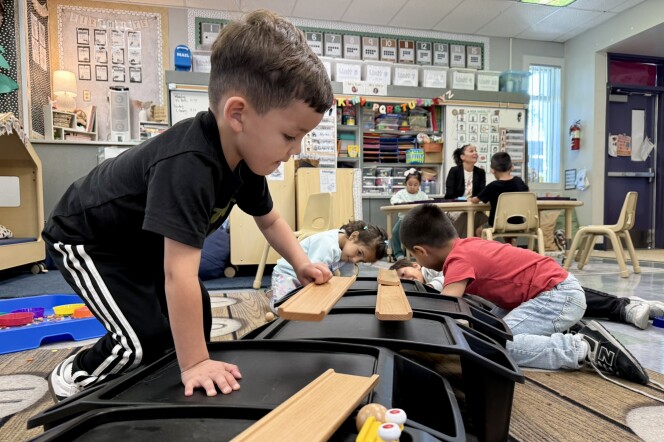With our free press under threat and federal funding for public media gone, your support matters more than ever. Help keep the LAist newsroom strong, become a monthly member or increase your support today.
Here's LA County's Vision For Saving The Air And Getting People To Drive Electric

Regional leaders have set an ambitious goal for Los Angeles County: to reduce its air pollution and greenhouse gas emissions by 25% before the Olympics comes to town in 2028.
And to get there, they envision a dramatic increase the number of electric buses, freight and delivery trucks -- and personal cars -- on SoCal roads.
But how would we get there? A map would probably help, so the Transportation Electrification Partnership (TEP) -- a coalition of local governments, public agencies, utility companies and car makers -- created one last year.
An updated version, dubbed Zero Emissions 2028 Roadmap 2.0, was released this week.
"We can't turn the tide on the climate crisis until we work across sectors and city limits to put the brakes on dangerous pollution and kick our zero emissions transportation future into high gear," L.A. Mayor Eric Garcetti said in a press release Tuesday.
TEP was formed by the Los Angeles Cleantech Incubator (LACI), which was founded by the city of L.A. and its DWP to boost clean technology innovations in the growing green economy.
Its roadmap was designed around four "guiding principles":
- Move people and goods emission-free by 2028, including visiting Olympic spectators and athletes
- Create ample, accessible charging infrastructure for electric vehicles to "eliminate range anxiety"
- Achieve a more equitable L.A. through improvements to air quality, job prospects and mobility access
- Grow the Greater Los Angeles Area economy through investments in electrified transportation
Regional leaders hope to achieve all that by focusing on three general "targets": how people move, how goods move, and how the region's energy infrastructure makes those first two targets possible.

The first version of this roadmap, released in September 2018, was similarly ambitious, but also loose with its goals and lacking detail on how to achieve them. For instance, last year's roadmap aspired that 20-45% of private cars would be electric vehicles (EV) within 10 years.
Roadmap 2.0 sets more specific targets. In the case of the private EV adoption, it's now squarely aspiring for 30%, with a related goal that at least 80% percent of all vehicles sold in the county be EV by 2028.
Here are several other goals county leaders hope to achieve in time for the Olympics:
- Install 84,000 public EV chargers countywide
- Electrify 100% of shared cars, meaning taxis and TNC vehicles like Uber and Lyft
- Shift 20% of all single occupancy vehicle trips to zero-emission trips on public transit or "active transportation options" (that means bikes, electric scooters and good old-fashioned walking)
- 100% electric fleet for all Los Angeles Metro and LADOT buses
- Expand and improve SoCal's power infrastructure "to meet the rising needs from transportation electrification" (aka, a grid that's able to handle all those new chargers everyone will need to power their EVs)
Much like the Paris climate agreement (which the U.S. is exiting, in case you forgot), the goals outlined in this document don't establish any legal mandates or accountability.
But according to Matt Petersen, president and CEO of LACI, the hope is that this blueprint serves as a beacon to launch pilot programs and policies to get to that reduced emissions future.
"It's ambitious but ... without a target that's near-term, it's hard to mobilize people to work together to get there," he told LAist. "It's really that collaboration -- how to get people rolling up their sleeves and committing to doing something bold;, automakers and policy makers committing to targets. Yes, there's no force of law in any of these targets, but they're still all committing to it."

One other big idea highlighted in the roadmap: turning the 710 Freeway into the first "zero emissions goods movement corridor" in the nation by 2028. That speaks to a longstanding emissions concern: the 710 Freeway is the main artery for diesel-burning trucks hauling goods from the ports of L.A. and Long Beach.
A project is already underway to widen the 710 corridor, but TEP's goals could inform how that expanded freeway works. The roadmap outlines plans to convert the current fleets of diesel trucks used to move cargo from the ports to electric trucks, Petersen explained. Another plan: creating a dedicated lane on the 710 Freeway for those trucks to use.
"[That] would be a huge incentive for drivers, operators and truck brokers to invest in zero emission trucks if they get extra time by having a dedicated lane," he said.
Several different types and sizes of trucks move freight to and from the ports, and Roadmap 2.0 sets specific goals to convert a portion of each type to electric and/or zero emission vehicles by 2028:
- 40% of short haul and drayage trucks
- 60% of medium duty delivery trucks
- 5% of heavy duty long haul trucks
Electrifying all those trucks will be "the biggest lift,"Petersen told LAist, given the limited infrastructure currently available to charge electric trucks at scale. The goal is to have up to 95,000 zero emission chargers installed for goods movement purposes by 2028.
TEP is also studying the feasibility of zero emission last-mile delivery zones, Petersen said. That means reducing the number of big, polluting delivery trucks in neighborhoods and commercial hubs and replacing them with electric cargo bikes, drones or other technology to bring you all those online orders.
The goals in the TEP roadmap are technically separate from the city of L.A.'s Green New Deal, which Garcetti announced back in April, though any progress from the regional initiatives will likely help the city achieve its own emission goals, too.
You can explore the 33-page report for yourself here:







